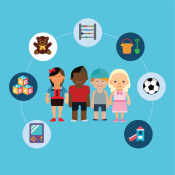Critical Information
The number of children ages 3 to 17 struggling with anxiety or depression rose by 1.5 million between 2016 and 2020. Educators trained in resilience will fortify their students and raise their potential for learning.
Two modes for promoting student resilience
Synchronous solutions…
include facilitated small group discussion, coaching, workshops, and more. Our unique web events include live group therapy, humor workshops to infuse fun into the classroom and even live events with comedians. Enjoy the video example.
Asynchronous solutions…
include on-demand video engagements on a range of topics from autism to dealing with difficult students. Faculty (and parents) can learn the rubric for developing greater resilience, will pass along this learning to students. Please enjoy this video montage on student engagement from our on-demand video library.
On-demand virtual engagements

The Me I Foresee Part III
The words that follow “I Am” follow YOU! Teach students how to describe themselves using constructive words and affirmations! Self-work that influences identity begins with our internal dialogue.

The Me I Foresee Part IV
Your mind's eye is where we vision how to be powerful, formulating new actions. Turn can’t into can and dare to escape! Promoting positive dialogue, through hopeful self-talk!

The Me I Foresee Part V
Unplug, Disconnect to Reconnect. Put down the device and let’s get moving. Teach students how to track healthy habits for emotional and physical resilience!

The Me I Foresee Part VI
Let’s examine ways to take ownership and the things we CAN control in the classroom

The Me I Foresee Part VII
Teach goal setting through a systematic process. Name it, plan it and do it! With concrete goals we can take risks that build greater self-worth.

Three Simple Tools for Student Engagement
Engaging students is becoming a more challenging task. Often times the decision to put extra time in a child is weighed against the pressure of outcomes. Learn simple ways to have both.

Tips for Receiving Feedback Part I
Feedback can sometimes be an uncomfortable topic. Appreciate and accept the benefits that feedback can have on your classroom and life.

Tips for Receiving Feedback Part II
Feedback is part of the daily work environment. Learn how to distinguish between biased input and positive helpful input.
Success Stories

"Whole School Health Through Psychosocial Emotional Learning highlights the importance of relationships, communication, and compassion for others. It presents a critical view in supporting, training, and retaining teachers through the lens of engaging and modeling behaviors that will help our rural students be better civic leaders and community members. My favorite quote from the book gives credit to the author's upbringing and modeling from his parents: 'We must experience the world through others so we can fully engage in educating all children. My father and mother modeled to me and my siblings how to experience the world through somebody else’s eyes, especially if their outer differences stirred up discomfort or displeasure, enriching all lives involved.' I recommend all leaders, teachers, and stakeholders secure their copy as they prepare for school."
Allen Pratt, Executive Director, National Rural Education Association (NREA)